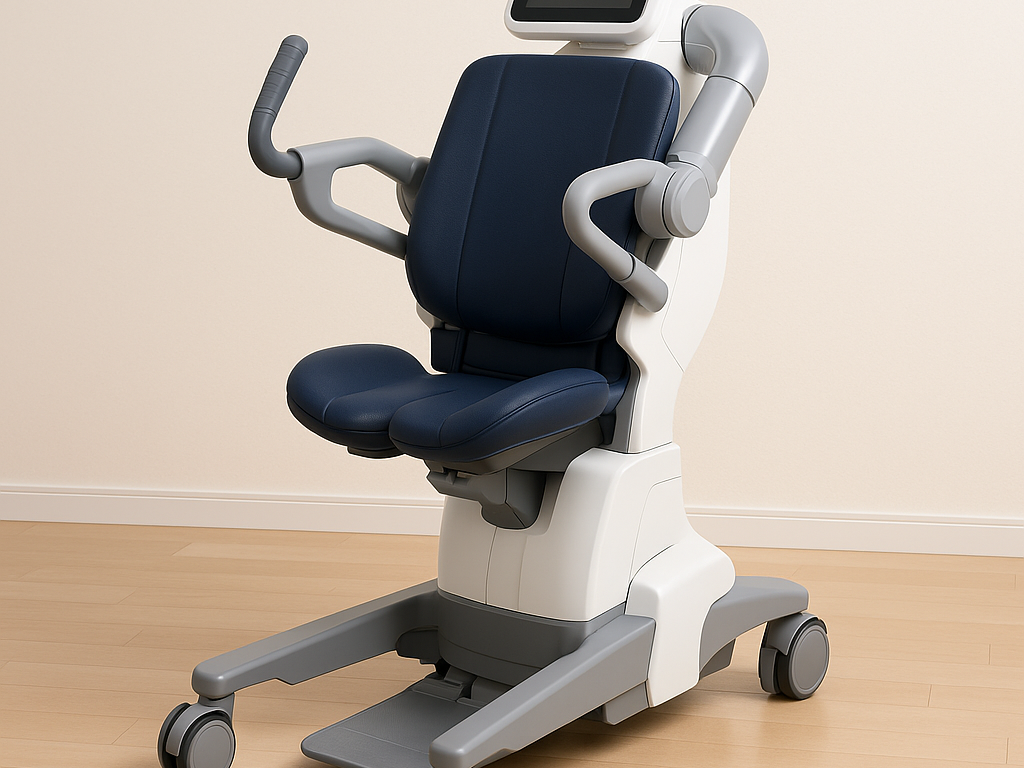I am Searching for a Caregiver Robot to Help Me with Transfers. Can You Help Me Please?
Transfer aid robots are changing the way seniors and individuals with disabilities move safely. These smart machines assist with bed-to-chair, toilet, and standing transfers—reducing caregiver strain and promoting independence at home.

Hi Diane, I am 71 years old and have been dealing with MS for 50 years. Currently I live independently, and use a scooter all of the time. I am searching for a caregiver robot to help me with transfers . Can you help me please?
- Phyllis
Hi Phyllis,
Thank you for reaching out. You are amazing for living independently while managing MS for 50 years! I think you are very forward thinking in exploring caregiver robots that help transfer you. I had to do a little research. The technology is always changing and improving.
Yes, there are robot helpers that can help with moving from one place to another, like from your bed to your wheelchair or from your scooter to a chair. These are called transfer-aid robots.
Here are some types that might help you:
1. Resyone – This robot can turn a bed into a wheelchair, making it easier to move without needing a lot of help.
2. Hug – This robot can help you stand up and sit down safely. It’s great for going from bed to wheelchair or toilet to wheelchair.
3. RIBA – This is a lifting robot that can gently pick you up and help move you from bed to chair or chair to bed.
4. AgileLife PTS – This one attaches to your wheelchair and helps you with transfers safely.
5. iBuddy – This is a smart robot that helps with moving around.
How they work:
• These robots use special motors and sensors to lift and move you gently.
• They are made to keep you safe and make it easier for caregivers to help you.
• They can even help you do things by yourself that normally need two people.
I’d be happy to help you learn more about these options and how to get one. Some may be available through medical supply companies or special programs. Let’s find the best one for your needs!
I created the Transfer Aid Robots Checklist for you. This will help you determine which transfer aid robot is best for you. Hey, if you invest in one, I hope you'll share a video of you using it.
Warmly,
Diane Carbo, RN
Founder, Caregiver Relief
Here's more extensive inform on the transfer aid robots
Guide to Transfer-Aid Robots: Choosing the Right Robot for Your Needs
For older adults and people with disabilities or chronic illnesses, getting from a bed to a chair, toilet, or wheelchair can be one of the biggest challenges. Fortunately, transfer-aid robots are now making these movements safer and easier.
This guide explores the different types of transfer-aid robots, with their benefits, limitations, and suggestions for who they work best for.
🤖 Bed-to-Wheelchair Robots
📍 Example: Resyone by Panasonic
How It Works: This robotic system turns part of a bed into a wheelchair, allowing smooth, one-person transfers.
✅ Pros:
- Allows safe transfer without lifting
- Designed for solo or single-caregiver use
- Great for nighttime or emergency transfers
❌ Cons:
- Only works with the special bed system
- Not portable
- Expensive
👤 Best For:
- People with no standing ability
- Users who want full independence
- Ideal for bedridden individuals who need to move short distances frequently
🤖 Standing & Sitting Support Robots
📍 Example: Hug by Fuji Corporation
How It Works: Hug gently assists the user in standing up or sitting down, using padded arms and motorized support.
✅ Pros:
- Supports natural movement
- Reduces caregiver back strain
- Compact and user-friendly
❌ Cons:
- User must be able to partially bear weight
- Needs proper setup and some training
- May not work for people with severe mobility loss
👤 Best For:
- Individuals with weak leg strength but some balance
- Seniors recovering from stroke or surgery
- Caregivers needing help with toilet or chair transfers
🤖 Robotic Lifting Arms
📍 Example: RIBA (Robot for Interactive Body Assistance) by RIKEN
How It Works: This robot has arms that lift and carry a person from bed to wheelchair or vice versa.
✅ Pros:
- Reduces need for human lifting
- Smooth, precise lifting
- Very useful for full assistance
❌ Cons:
- Not available commercially in most regions
- Requires a caregiver to operate
- Expensive and may need a large space
👤 Best For:
- People with severe mobility loss
- Non-weight-bearing individuals
- Professional care settings or high-tech home environments
🤖 Wheelchair-Mounted Transfer Robots
📍 Example: AgileLife PTS
How It Works: This robot is built into the wheelchair and lifts the user directly from bed, toilet, or recliner into the chair and vice versa.
✅ Pros:
- Always available with the user
- No need for separate lifting system
- Promotes independence
❌ Cons:
- May only work with specific wheelchairs
- Not suitable for very tight spaces
- Requires training and caregiver support during use
👤 Best For:
- People with moderate to severe disabilities
- Individuals with daily transfer needs
- Home or long-term care settings
🤖 Smart Mobility Robots
📍 Example: iBuddy
How It Works: iBuddy helps with walking, balance, and sometimes minor transfers. It combines robotic assistance with smart sensors for navigation.
✅ Pros:
- Multi-use: mobility, communication, safety
- Can reduce falls
- Encourages social interaction and reminders
❌ Cons:
- Doesn’t perform full physical transfers
- Not a lifting robot
- Best as a companion, not a primary transfer tool
👤 Best For:
- Seniors who can walk or stand but need support
- Early-stage Parkinson’s or MS
- People living alone who want robotic companionship and reminders
🧩 Comparison Table: Matching Robots to Abilities
| Mobility Level | Recommended Robot | Why |
|---|---|---|
| Fully immobile / bedridden | Resyone, RIBA, AgileLife PTS | Provide total lift or transfer support |
| Weak legs, partial standing ability | Hug, AgileLife PTS | Assist with standing/sitting and sitting transfers |
| Moderate disability, needs caregiver help | AgileLife PTS, Hug | Improve caregiver safety and reduce lifting strain |
| Stroke recovery or surgical rehab | Hug, iBuddy | Support light transfer or standing safely |
| Progressive illness (ALS, MS, late-stage) | Resyone, RIBA | Prepare for increasing support needs |
| Independent but aging, lives alone | iBuddy, Hug | Offers lightweight support, smart features, balance aid |
🏁 Final Thoughts: What to Consider Before Choosing
When choosing a transfer-aid robot, ask the following:
- What are the physical needs? (Can the person stand, bear weight, or move independently?)
- Is there space in the home? (Robots like RIBA need room to move.)
- Is a caregiver always present? (Some robots are for solo use, others need help.)
- What is the budget? (Robotic systems can cost between $5,000–$30,000+)
- Will insurance help? (Most robots are not yet covered but that’s changing.)
Heres the future in transfer aids Watch the video
Caring for a loved one can be overwhelming — but you're not alone. If you have questions, big or small, our expert team is here to help.
👉 Click here to Ask the Expert





